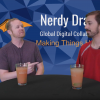By ndadmin on 03/11/2018
Jonathan Brendefur wondered why people struggled with math, then researched..and collaborated, published, innovated and...After years of persistence, he traced the root of the issue to early childhood education, identified 6 fundamental dimensions that can be measured, and built the only assessment tool that diagnoses a students ability and gives educators the information needed to give the right instruction to improve student outcomes. Not only that, he built curriculum, instruction, and professional development to help every person have the tools needed.
An academic entrepreneur.
Jason: Welcome to another episode of Decision Pints. Today our featured guest is Jonathan Brenda for of developing mathematical thinking, Institute of the University of Boise State University and many other things. We are talking over a pint of Snake River brewings, a extra Pale Ale and a look forward to the conversation. Cheers.
Jonathan: That was pretty good.
Jason: So this is a show about making things happen and the people who do it and in your case you've done so many things that we'll try to pare it down to the developing mathematical thinking institute at its at its center and how you got your start into creating this company and where your looking at going with it next. So tell us a little bit about a developing mathematical thinking and how you got your start.
Jonathan: So for me, I really want people in general just to understand mathematics and not just to understand it as arithmetic or computation, but really what is mathematical thinking? How do you think mathematically on all different topics? Kindergarten through twelfth grade. And so a number of different things happened to me when I started working with the Netherlands, the University of Utrecht, we had, that was our sister school when I was at the University of Wisconsin and the, the Dutch, they're really talked about what was called realistic math education. How can you visualize math, how can you connect it to the real world? And that really resonated with me when I was in graduate school and that's how I started thinking about, like ideas of tangent and sine and cosine and that originally just functions at the high school level a, and just building tons of connections. So when you bring up a topic, systems of equations, then can you actually think in the real world, look around and go, here's all the different ways that you could use systems. And then that sort of translating all the way down to preschool. So looking at it from four year olds all the way through high school, with just a goal of I want more people to really understand mathematics. And so that's where. So then my job and my team's job that I've been working with is really to help people develop mathematical thinking.
Jason: Excellent.
Jonathan: So a lot of people here mathematics and immediately this wall goes up thinking, oh yeah, because I'm intimidated, but not you. You, were interested in it. And as a researcher really started at the older ages and worked your way back, just finding, unwinding a, the thread finding earlier and earlier there were, there were things that were preventing people from having success later on. can you tell us a little bit about how long of a process was this research to get down to this kindergarten, early childhood education level and start to put the tools together that lets you create a company from him about 15, maybe 20 years of really kinda investing time in research and understanding how do people think about mathematics? And so I did start at kind of laugh at this, but, how do you, so our topic was functional reasoning sounds kind of funny, but I do sixth graders through twelfth graders a really understand functions in all the, all the different kinds from linear, quadratic, exponential tangent.
Jonathan: and as I started seeing holes where kids were actually able to really, take the real life situation and really mathematized take the math out of it, use it, create a function. I'm really talk about the coe relationships, the variance, the dependencies. And then all of a sudden I said, OK, well let's look more at the middle school range. And kids were struggling with place value and fractions and decimals. and then I started looking more at fifth grade. And finally I met, one of my professors, Elizabeth phenoma, she was wonderful. She said, you really need to spend time with kindergarten and first grade and understand what's happening at age five and six. So I started working with five year olds was a whole other experience. Some people think working at the high school level as a teacher was tough. You know, any kinder, first grade teacher, I might, they're impressive.
Jonathan: So, so that really got me involved in trying to help teachers at the elementary level understand the mathematics to then inform their teaching of mathematics. So that led to, a grant that I wrote and I was a math science partnership grant and I started working with three schools in the treasure valley and I gave them understanding of the mathematics, made the connections and the schools that achievement rates just started going up. so that got me, the first grant and that kind of led to thinking about, with a partner and I, what else to do with the company, which led to a couple other things that you may have questions for him.
Jason: I'm talking conversation. This is great stuff to persistence and perseverance on tackling a very complicated subjects and pioneering this research into getting at the root of helping people think mathematically because I seen multiple articles and I haven't reviewed the research, but, people who are better in math tend to be happier, healthier and wealthier. and as a young children grow into adults, this company that you've put together is helping to build a solid foundation to improve the lives of these kids, which is inspiring for those of us that see what you're doing. so first off, thank you for inspiring us. And second, can you tell us a little bit more about kind of the evolution of this research into the building of a company?
Jonathan: You're going to six? I haven't talked about company. Yeah. Yeah. So that led to, one of the teachers I was working with was really fantastic, Sam's brother. And so I ended up hiring him after one of my first projects to start working with me at the university and one of our first projects was with the State Department and I'm the math coordinator at the time. Had asked what, what screeners are out there for young kids, for kinder, first and second. So we really started looking into that and read a lot of research over a hundred articles and was really some fascinating findings where we were, we thought, OK, the screeners out there across the US are screening young kids on and do the other facts, can they count for, can account back and the identifying numbers. I'm cleared a bit with relational thinking.
Jonathan: it's simple as does three plus four equals five plus two. Can you look at those relationships? but as we started reading it was really measurement and spatial reasoning that became the crux of being able to determine whether the kids are gonna have huge holes and get through mathematics all the way into junior high and high school. And so then we started looking across again for screeners across the United States and we weren't seeing them. So we s we said, well, let's start developing. Once we developed a paper pencil one. And then a colleague of mine out in Washington said, I am running a company, I've got some programmers, let's actually build it online. And so that's where we actually formed the company. He and I formed developing mathematical thinking institute and so then, that kind of started that first, push into just looking at the assessment and trying to work with schools and we got a grant to really work on that as well. Then that's led to then creating more resources and just kind of building up from that k through k, six k eight kind of expanding and we also then do a lot of professional development working with teachers out in the, in the classrooms
Jason: [inaudible] that how exciting and so you're intervening and helping to measure and find opportunities to improve the education of the kids. but then it's actually not quite that easy because it's really teaching the teachers about these fundamental principles and how to isolate the areas that the student needs further instruction and given the activities and then follow through with making sure that they are improving. So can you talk a little bit about maybe some of the difficulties that you've run into as you've,
Jonathan: gone through? so a lot of element for good or bad and it gets a lot of elementary teachers aren't for elementary teachers go into teaching usually because they are there, they're focused on reading and getting kids to read. So mathematics isn't always just trying to say that nicely isn't always their main focus. And so then we try to, we do go into schools and really work on how do you teach geometry, how do you teach measurement, high cheech number better so that we can really get those kids to understand the mathematics talk mathematically and then build that foundation all the way up. And so it is a struggle where we have to really work with teachers to get a lot of content knowledge and then also pedagogical knowledge, the knowledge and actually teach. So if a kid doesn't understand fractions, are placed value, what is it, what types of tasks we actually give them. And so that's through, because that became an issue, the tasks, we actually started creating tasks. And so that's what we end up creating a curricular resources to really help teachers. and and we used a powerpoint format so that you could pose a question to the kids, but then if the kids are, when the kids answer, then you'd say, this is how you actually want them to speak mathematically. This is the type of way you want them to respond to it. So then we can, we can animate that in the program
Jason: was fascinating. So as you went through and started developing the curriculum resources, were there existing models that you built from or, or did you do a lot of independent pioneering into putting those lessons in items together?
Jonathan: So we ended up, we ended up going a different route because we looked at all the curriculum that was out in the United States and what were the holes and the two biggest holes that students weren't visually looking at mathematics. And so that visual spatial way of looking at math is key to success later. engineering schools. If you look at school on, different engineering schools, like, what is the school? And in boulder or Golden Colorado, they, you have you take a test on spacial reasoning to get into the school to become an engineer now. So engineering becomes just a, or sorry, a spatial reasoning becomes critical. So how do we really infuse a, a way of looking at the mathematics through a visual. I'm a visual patterns, and modeling. And then the second one was the language. What is the structure of math that you could decompose, you compose things, you iterate, units, you partition things. all of our algorithms become different ways of decomposing, composing by place value. And so giving them the language and the visual to understand to them do the operations and become both fluent at the mathematics and flexible enough to be a good problem solver at the same time. So that was kind of our take on trying to be different than a lot of other things that are out there. They're just practicing worksheets on their skill level. So we want that plus the language in this.
Jason: So I, I look at just building that curriculum seems like such a massive undertaking yet that's one component of the developing mathematical thinking institute and Developing Mathematical Thinking Institute is one component of your life. You're still active professor, you're still a researcher and a publisher. You're still a, an advisor for phd students. how, how in the world do you find the time to do all this?
Jonathan: That's a great question. I don't sleep much. Ah, yeah, I actually really enjoy the work. So I like the, for me the university work is really nice because it forces me to read a lot, so I stay up on the literature. Then my writing the articles and writing the grants also forces me to be. I'm just immersed in what's the, every year, every couple years there's little movements so I get to stay, stay up on that, which then leads to, when I'm out in schools I'm like, oh, these kids are struggling with this idea, let's try this. idea and then trying this idea of and translates to later at home creating curricular items. and then I work with my other colleagues and my staff on, on seeing if these ideas work over time, which then generates more curriculum and then, and then that ends up feeding back into what's the research say, what types of, grant should we write? And then so that kind of becomes circular. So half my time is over here at the university level and the other half is building other company stuff. The companies has so many other features though, to just all the. There's a lot of other components that I had no idea about it.
Jason: I love. The more that I hear, the more I learn, the more interesting and exciting it is because here is a fundamental part of everybody's life. And on the education side, it's, it's part of our current education, but you've found some major areas of deficiency and have worked not only to research what the problems are, but engineered solutions for it, validated those solutions with research and measurement in peer reviewed academic work. And that's still the tip of the iceberg because you're still out, putting on seminars for teachers. When somebody has a question, about the company, you're on the receiving end of the email and you're answering and they're calling you and when somebody is a password of a teacher doesn't work, you're part of the solution and it's, it's such a feel-good story, really the subject matter of the inspirational story of how you came to build what you have and it is incredibly exciting to look forward to where you'll go from here. So with that, let's take a moment and talk about what's next for the developing mathematical thinking institute and Yourself.
Jonathan: I like being at the university that really keeps me grounded, working in the schools with the research than I had liked that component. for, for the DMT, for, for the business. It's kind of exciting. We're moving to really work with more schools. We would like to work with schools that are title one schools that have, are in poverty where there's not always teachers with math degrees or that have a, just a lot of instructional issues. And so we'd like to work with schools like that. So we want to keep building that. I'm really wanna increase the type of resources, so we were moving away from a workbooks and a curriculum that's always on the page, so now we can do it electronically where students can have notebooks and journals and so that's, that actually frees up a lot of money for schools instead of spending so much on these curriculum adoptions too much easier and we can actually, modify the curriculum quickly and get it back out to teachers.
Jonathan: So that's pretty exciting. And then also moving toward, creating a cup, another set of assessments. So we have the primary math assessment for the [inaudible] level. We also want to build a three, four, five. So, how do we really key in on, on holes that kids have at the third grade, fourth grade, fifth grade, so we can help that aspect. And then, we want to start moving, to doing more apps. so kids can actually get more practice. That's really key ideas that they don't get practice with. A lot of that is the measurement and geometry type of items. and then, kind of moving out toward parents now too, and seeing if maybe that's a way that we can generate more excitement, more parents can start getting, they're getting, getting involved, getting their students to really understand the mathematics
Jason: that's incredibly exciting and impactful and benefiting the world in a positive way. it's an honor to have you here with us today on decision pints. Thank you so much. Thank you. Thank you everybody that tuned in. Thank you David and [inaudible] immersive. look forward to seeing you again soon.
Jonathan: Thank you.










